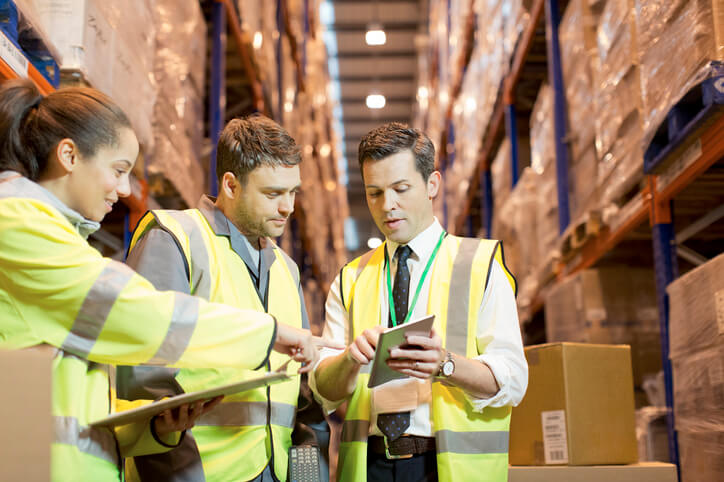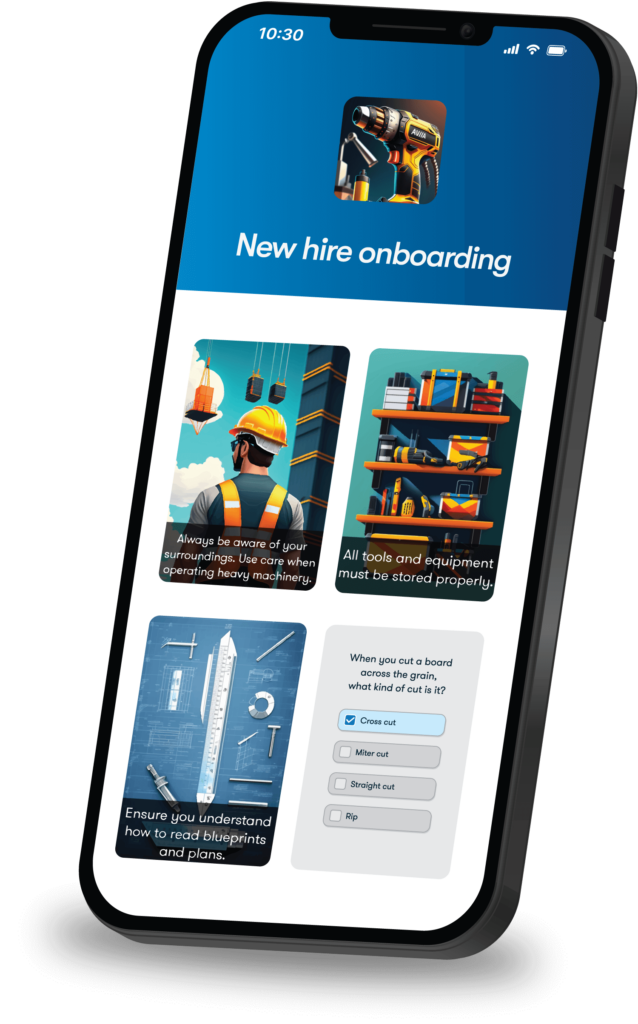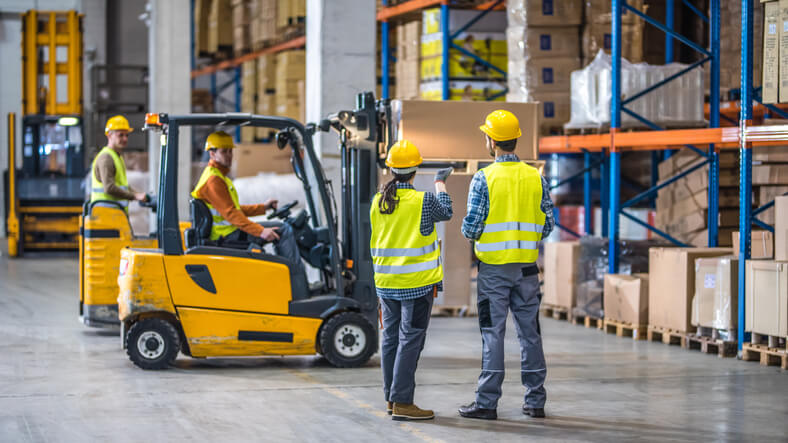Logistic safety is an industry pillar that has to go beyond practice. It must be a part of your company culture.
In logistics and transportation, workers navigate a landscape where urgency meets precision, and every movement carries the weight of efficiency. However, within this dynamic industry, the risk of accidents looms large due to its nature— a bustling environment brimming with moving parts, heavy machinery, and time-sensitive tasks.
Because of this, fostering a “safety first” mentality can’t be left to simple onboarding training sessions. Having a strategy that is implemented and cultivated every day is non-negotiable.
What is logistics?
Logistics involves the movement of goods, services, and information from origin to destination. It manages procurement, storage, order processing, transportation, and distribution.
Vital for supply chain optimization, it guarantees timely deliveries and customer satisfaction. Logistics security fortifies goods during transit, preventing theft or damage, and ensuring safe resource movement. Simply put, logistics ensures the seamless flow of materials across the supply chain.
Why is safety important in logistics?
Following OSHA’s safety guidelines from 1970, there has been a 62% reduction in occupational fatalities and a 42% decrease in workplace-related injuries. Having a clear safety plan is no accident. With so many moving parts, logistics safety must be baked into your company’s culture to ensure your staff works in a safe environment.
Safety is crucial in logistics for several reasons:
- Protection of people and goods
Logistics safety measures help protect the well-being of workers, drivers, and the general public, as well as the goods being transported or stored.
- Regulatory compliance
Adhering to safety regulations and standards is essential for legal compliance and avoiding potential penalties.
- Cost reduction
Implementing safety measures can reduce costs associated with accidents, injuries, and illnesses, which can have a significant financial impact on your business.
- Brand reputation
A safe and healthy supply chain reflects a company’s commitment to safety, enhancing its brand reputation, and building customer trust.
- Operational continuity
Safety measures help maintain operational continuity by preventing accidents that could disrupt the flow of goods and services, ultimately impacting business operations.
How to create a safety-first culture in logistics
1. Employ continuous learning
Logistic safety training isn’t a one-time event.
In fact, it must be a continuous learning process to create a culture of safety. This can only happen by implementing continuous learning events around safety practices. The best way to train your deskless workforce is through a high-quality mobile training platform.
Employers are legally responsible for equipping their workforce with comprehensive knowledge, training, and supervision essential for their roles. Regular evaluation of staff education needs remains crucial, especially when catering to increased customer demands or hiring new personnel. All new hires should undergo rigorous safety training, while existing employees should continuously update and refresh their knowledge.
Safety training should not be limited to newcomers; continuous education is key. Having on-demand training available is one pillar of a continuous education program. This doesn’t have to be a huge learning event. Training logistic safety in short bursts is more effective using microlearning lessons. These are vital to reinforce safety practices and adapt to changing operations, including new equipment and processes.
We live in a time of information overload. To retain critical learning, we must first consider the concept of the Ebbinghaus forgetting curve. This concept highlights the rapid decline in retaining new information; hence, regular reinforcement is crucial. Short, concise safety lessons, incorporated with spaced repetition apps, aid in solidifying memories and combating the effects of forgetting. These bite-sized lessons are particularly beneficial for organizations with remote workers.
2. Transform the attitude around safety audits
Safety audits are pivotal in maintaining a secure work environment within logistics settings. These audits enable supervisors to meticulously assess facilities, identifying potential health and safety hazards for prompt resolution. However, supervisors might only detect some risks, underscoring the importance of worker involvement in identifying dangers. Unfortunately, employees often hesitate to voice concerns during audits, fearing repercussions from the company.
It falls upon CEOs and supervisors to assure workers that highlighting hazards is essential for workplace safety. Staff often fears that audits will be punitive in nature. It’s up to leadership to create a culture where safety concerns are met with gratitude and not punishment.
How is this accomplished?
Leadership must earnestly listen to and address worker complaints seriously.
To transform safety audits from intimidating assessments to collaborative endeavors, it’s crucial to shift the perception. Instead of being viewed as inspectors in a “gotcha” mode, audit teams should emphasize collaboration, aiming for shared safety objectives.
Building personal relationships and fostering regular interactions beyond audit times help demonstrate a genuine commitment to workplace safety. Actively engaging with associates, listening to their concerns, participating in safety-related discussions, and involving floor employees during audits fosters a culture where safety is a priority and a collective responsibility.
Encouraging a team approach during safety audits, where management walks the facility with employees, actively seeking safety improvement opportunities, promotes a collaborative and interactive process.
This approach facilitates gathering information and cultivates a shared understanding that safety is a genuine priority, strengthening the commitment to a safe working environment.
3. Encourage open communication
Creating an atmosphere of open communication is key to building a safety-focused culture at work. Leadership must reassure employees that pointing out potential hazards is essential for a safe workplace without fearing negative consequences.
Safety is everyone’s responsibility, and leaders should take workers’ concerns seriously to maintain a secure work environment.
One way to collect feedback is through a pulse survey. This quick and targeted approach allows you to gain targeted feedback on a specific topic. When done effectively, you gain clear insights into the topic or issue.
Open and clear communication is the backbone of accident prevention and cultivating a safety-oriented culture. It’s about sharing information openly, not just from the top down but also encouraging feedback from all levels. To make safety a natural part of how things are done, it’s essential to prioritize transparent communication across the organization.
4. Make safety resources easily available
Ensuring the availability of necessary resources like personal protective equipment (PPE) and safe vehicles is vital for enhancing workplace safety.
Besides providing workers with industry-specific PPE, supervisors must wear this equipment, setting an example for safety practices on the floor.
Warehouses should also have readily accessible safety equipment like signs and alarms for daily use. Regular maintenance and timely repairs of all materials handling equipment and fleet vehicles are essential to ensure they’re in optimal working condition.
Finally, safety guides and training materials should be easily accessible to all employees. By digitizing those resources and making them available in a mobile application, you can ensure that employees no longer need to consult bulky paper manuals when they need a refresher on specific processes and protocols.
5. Praise in public
Recognizing and celebrating safety achievements is another powerful way to foster a safety-first culture within your company. Implementing spot bonus programs or publicly acknowledging employees who actively report near-misses can reinforce positive behavior and encourage greater participation in safety initiatives.
Transparency and accountability create healthy competition among facilities, motivating teams to excel. However, it’s crucial to ensure fairness when comparing different facilities, considering variations in automation and manual activities that might impact safety records.
Encouraging friendly competition while maintaining fairness among diverse operational settings is key to leveraging competition as a motivational tool.
One way to drive down Recordable Incident Rates is by maintaining high visibility of safety metrics in daily operations. Displaying metrics such as days without incidents and other safety and compliance measures fosters a sense of pride and ownership among associates, prompting them to strive for better performance.
Creating a safety-first culture within logistics requires consistent effort. Prioritizing logistic safety will lead to a safer, more efficient, and profitable operation.
Make training accessible anywhere with a powerful mobile learning app

FAQs
What are the 4 types of logistics?
The primary logistics types include:
- Inbound logistics: Moves raw materials to departments or manufacturers for processing.
- Outbound logistics: Ensures timely product delivery to customers, covering packing, shipping, and inventory.
- Reverse logistics: Manages product returns, recovery, and recycling.
- Third/Fourth-party logistics: Outsourcing supply chain management for efficiency.
What are the 4 key processes in logistics?
The core logistics processes include:
- Procurement: Sourcing and acquiring goods and services.
- Storage & inventory management: Efficiently managing stock levels and storage.
- Order picking & dispatch: Preparing accurate shipments for timely delivery.
- Transportation & distribution: Moving goods to their final destination efficiently.
What is logistics security?
Logistics security safeguards goods, people, and data during transport and storage. It prevents theft, damage, and ensures safe resource movement. Measures include remote monitoring, warehouse security, and trained personnel for perimeter, interior security, gate control, and emergency response. It’s vital for risk reduction and safe supply chain operations.
Ensure that safety comes first
Making logistics safety a top priority is key to a secure work environment. A mobile training platform ensures ongoing education, keeping everyone updated on safety practices, and makes it easy to deliver toolbox talks.
Prioritizing safety in logistics isn’t just about compliance; it’s about valuing every individual’s well-being and ensuring a culture where safety comes first.
Key takeaways
- Continuous learning is essential for upholding a safety-first culture in logistics and adapting to evolving safety protocols.
- When collaborative and inclusive, safety audits contribute significantly to maintaining a secure work environment.
- Open and clear communication channels are vital for addressing safety concerns and fostering a safety-oriented culture.
- Ensuring the availability of resources like PPE and safe vehicles is crucial to enhance workplace safety.
- Recognizing safety achievements and maintaining the visibility of safety metrics promote accountability and motivate teams to excel.
Build technical training your teams can access anywhere with TalentCards



